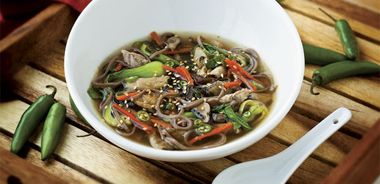Chicken Noodle Soup

Serves 6
Here is a nutritional upgrade of the iconic soup that offers a fiery Asian twist. The searing bird’s eye is a smaller and more potent version of the jalapeno. If you want your soup to pack more of a punch, include more bird’s eye seeds.
1 1/2 cups (350 ml) sliced dried mushrooms
2/3 package (about 6 oz/170 g) soba noodles
3 tsp (15 ml) grapeseed or coconut oil
1 lb (450 g) skinless, boneless chicken thighs, cut into 1/2 in (1.25 cm) slices
2 medium-sized carrots, sliced julienne-style
2 garlic cloves, minced
2 spring onions, white and green parts, thinly sliced
1 bird’s eye chilli, thinly sliced
3 tsp (15 ml) finely minced ginger
1 1/2 tsp (7 ml) Chinese five spice powder
1/4 tsp (1 ml) sea salt
5 cups (1.25 L) low salt chicken stock
6 baby bok choy, thinly sliced
2 generous Tbsp (45 ml) wakame flakes (optional)
1 1/2 Tbsp (30 ml) sesame seeds
Place mushrooms in bowl, cover with cold water and soak until softened, about 30 minutes. Drain, reserving soaking water.
In large saucepan, prepare soba noodles according to package directions. Drain and rinse.
Return pan to stove and heat oil over medium heat. Add chicken and cook until no longer pink, about 6 minutes.
Stir in carrot, garlic, spring onions, bird’s eye chilli, ginger, five spice powder and salt. Cook for 1 minute. Pour in stock and 1 cup (250 ml) mushroom soaking liquid. Bring to a simmer and then stir in mushrooms, bok choy and wakame flakes, if using; heat for 2 minutes. Stir in soba noodles.
Divide soup among serving bowls and garnish with sesame seeds.
Each serving contains: 1105 kilojoules; 22 g protein; 7 g total fat (1 g sat. fat, 0 g trans fat); 30 g total carbohydrates (3 g sugars, 2 g fibre); 471 mg sodium
source: "Red Hot Chilli Peppers", alive Australia #20, Winter 2014





